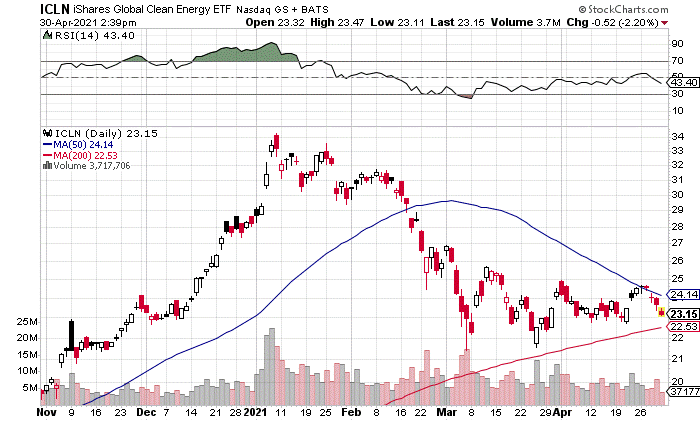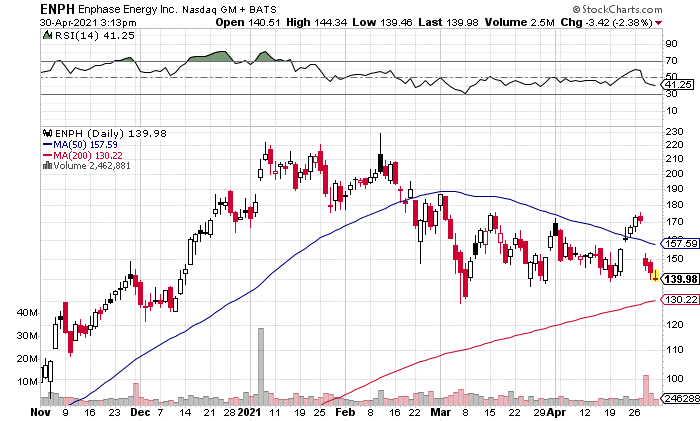If you've been with me for a while, you'll know I've been extremely bullish on the long-term outlook for clean energy stocks.
I'm sure you remember a time when these were "alternative energy" stocks, but we're rapidly coming to a point where there isn't much of an alternative. You can chalk that up to social change or economics - or both - but either way, it's inescapable.
The president just addressed Congress to talk about pivoting, on a national scale, to clean energy; he's not alone, as countries all over the planet are looking hard at, and, in many cases, making the pivot, too. Worldwide, trillions will ultimately be pumped into the clean energy sector to make this happen.
But it's not all about granola and cozying up to trees - there's definitely another kind of green(back) consciousness at work, too.
A Morgan Stanley automotive analyst wrote in February that, as soon as 2030, gasoline-powered internal combustion engines will likely become unprofitable for the automakers like GM and Ford." Think about that for a second. Then consider that, earlier this year, General Motors said it plans to stop selling vehicles with "tailpipe emissions" by 2035. GM is the first of the old-school "Big Three" to commit.
So, if clean energy is "The Future," why has the sector been tanking, almost totally uninterrupted, since the middle of winter?
You'll understand exactly why when you see my charts. What's happening is a classic "buy the dip" scenario on stocks that could snap back 50% or more before long.
And I've picked the best one to buy...
Why the Power-Packed Sector Is Wheezing
The clean energy sector, as tracked by the iShares Global Clean Energy ETF (NASDAQ: ICLN) was positively red-hot in the fourth quarter of 2020 and a few weeks into the first quarter of 2021. We saw some stocks post 50%, 70%, 100% gains over the course of a few months - and my Night Trader subscribers got the chance to bank some nice wins there.

But as you might imagine, I watch this sector's technicals like a hawk - and I watched the clean energy trade get seriously overcrowded in February. That's always the problem with "red-hot," isn't it? You can see it on the chart.
Crowded trades can often see exaggerated downside moves, particularly when traders realize what's happening; no one wants to be the one holding the bag on a sinking ship when the music stops. So, a "snowball" effect occurs as hasty mass exits are made. That's what's driven these stocks down anywhere from 35% to 50% over the past two months or so.
You can see buyers started to be tempted back in March but were unable to change the trend for long. The technical "juice" needed to sustain a rally just wasn't there.

Cash In on the "Dumb Money"
As more and more amateur traders throw speculative money into the markets, the profit potential for us grows...

Cash In on the "Dumb Money"
As more and more amateur traders throw speculative money into the markets, the profit potential for us grows...
When the snowball rolls a little too far or a little too fast down the hill, conditions become favorable for a trend reversal; a classic "oversold" situation develops. That's exactly what's happening here on the ICLN, as the relative strength index (RSI) hurtles down toward 30. The closer it gets to the 30, the more likely a powerful rally can take place, and with a sector like clean energy, that rally is probably inevitable, and should be significantly more sustainable (no pun intended) in the long run.
I think you can't go wrong with the ICLN ETF now - in fact, I just recommended a big Fast Profits trade on it last week.
But no one should miss out on the profit potential in this company...
Here's the Clean Energy Stock to Own Now
The "Best in Breed" pick in this sector is Enphase Energy Inc. (NASDAQ: ENPH).
Its chart tells a similar story to the broader ICLN - a story of a rapid, nosebleed-inducing rise and a long, painful fall - this stock has actually been searching for a bottom over the past few weeks.

The bottom, folks, is now, at the $140 level. Buying at the bottom is my favorite way to buy the dip - makes it much easier.
Enphase just turned in a dynamite set of quarterly results that beat most estimates, but management offered dampened forward guidance on this thanks to the ongoing semiconductor shortage - which, in and of itself, is just more support for my conviction that clean energy is the new tech sector. But more forward-thinking buyers - like us - are beginning to filter in and settle in for what I'm expecting will be a long, incredible run.
Buy ENPH shares at market and set what I think is a conservative price target of $210, which would be about a 50% gain from these levels.
Clean energy is getting its second wind as a lot of the "noise" and jostling that brought it crashing down is fading away.
That said, "noise" isn't necessarily a bad thing - particularly when you know the real story. There are around 72 million new players in the market since 2020, a lot of them trading on noise, with pretty much no regard for risk - at all. These folks have been seen to throw up to $11 million around a second. That's around $970 billion a day.
My colleague and Profit Strategies Podcast co-host, Tom Gentile, watched this "Millennial Mania" unfold, same as we all did, but he had a hunch, an interesting idea to back-test the big volatility "surges" these new investors and traders can create. Know what he found? Opportunity. Big-time profit potential. I'm talking an average return of 35% in just eight days, but some of the biggest wins include 1,000% in three days, 2,500% in 16 days, and even 3,800% in six days.
The dumb money is clearly out there running wild - you've got to check out Tom's research on how regular investors, with the right stakes and strategy, could see big profit potential because of it.
Follow Money Morning on Facebook and Twitter.
About the Author
Chris Johnson (“CJ”), a seasoned equity and options analyst with nearly 30 years of experience, is celebrated for his quantitative expertise in quantifying investors’ sentiment to navigate Wall Street with a deeply rooted technical and contrarian trading style.



